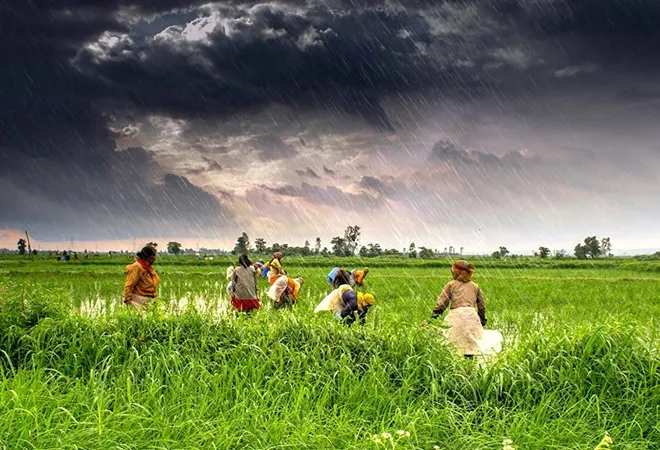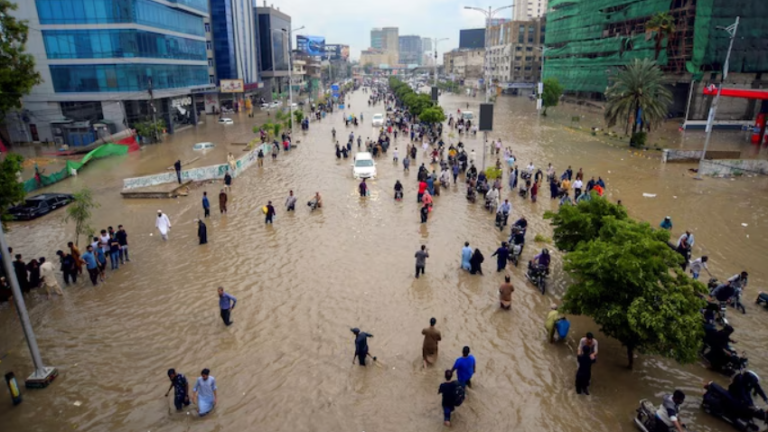Weather, trade restrictions, rising oil prices, a lack of financial support for farmers, and other factors have contributed to the destabilization of South Asian food security. The purpose of this study is to determine the long-run and short-run relationships between climate change, agricultural credit, renewable energy, and food security for a sample of South Asian countries between 1990 and 2021. The Dynamic Common Correlated technique is utilized for empirical analysis since it directly addresses the issue of cross-sectional dependency while delivering accurate cointegration findings. The study’s empirical findings show that climate change reduces food availability and increases the incidence of food insecurity in South Asia. In contrast, the use of renewable energy sources has a positive effect on food security in the short-run but not in the long-run, while the availability of credit to farmers has a positive effect on food security. Findings suggest that South Asian countries may reduce climate change’s negative effect on food security by investing in climate services, climate-resilient infrastructure, growing drought-resistant crops, using supplemental reinforced agricultural practices, and improving their weather forecasting capabilities.
Introduction
Agriculture serves as the predominant economic pursuit in South Asia, a region where around 70% of the population resides in rural areas. The region of South Asia has a geographical area of about 5.1 million square kilometers, with around 39% of this land being classified as arable. The region under consideration exhibits a significantly elevated susceptibility to land and soil degradation. This vulnerability may be attributed to its relatively small land area, accounting for about 3.4% of the global total, juxtaposed with a substantial population size, con- stituting one-quarter of the world’s inhabitants, estimated at 1.75 billion individuals. Consequently, the adverse consequences of land and soil degradation in this region have the potential to impede agricultural productivity (FAO, 2022). The degree of food security in a country is primarily determined by the production of food. Access to reliable and nutritious food for a population is directly influenced by the volume, quality, and dependability of food production. By providing a sufficient supply of food, and diverse food production helps to increase food security. Global factors are crucial in affecting the capacity of a country to produce food. Extreme weather events, trade restrictions, and risingoil prices have resulted in the destabilization of food security in the area. International trade agreements, tariffs, and disputes over trade may have an impact on a nation’s ability to import essential food supplies. Moreover, water-induced erosion has degraded 25% of the land that is utilized for pasture and crops. The fertility of the soil is declining, particularly in tropical regions of South Asia, whereas a significant issue in the hills and mountainous regions is soil erosion brought on by the summer monsoon (Dahal, 2017). The increasing temperature also affects soil fertility. In South Asia, around 412.9 million people are severely food- insecure, making up 21 percent of the total population, while food security is low in 40.6 of the total population (FAO, 2022). In addition, it is worth noting that the COVID-19 epidemic has exacerbated the issue of food security in the region, especially in conjunction with the ongoing challenge of climate change (Rasul, 2021).
Any variation in climatic factors can have a direct impact on a country’s ability to feed its people (Fujimori et al., 2019; Misiou and Koutsoumanis, 2021). Many of the small-scale farmers relying on rain-fed croplands for livelihoods make up a significant portion of the sector that is most prone to be impacted by climatic change (Hanjra and Qureshi, 2010; Campbell et al., 2016).Pakistan is among the countries susceptible to climate change and has recently experienced more than 190% rain in June-August 2022 compared to its 30-year average.1 According to the United Nations, about 800,000 farm animals died and 2 million acres of orchards and crops were destroyed. However, in India, a blistering heat wave devastated wheat harvests throughout large portions of the country in the summer, and increasing temperatures and unpredictable rainfall have harmed agricultural production overall. One of the reasons for the recent economic crisis in Sri Lanka followed by food insecurity is fertilizer prohibition and climate change. In Sri Lanka, around 2.5 million people rely on climate-sensitive industries, for example, agriculture and fishing, for a living, therefore, climate change is responsible for 96% of the hazards in the country. In the face of climate variability, access to climate-related information can play an important role in improving food security in South Asia by providing information and tools that can help farmers and policymakers make more informed deci-
sions about agricultural production and food systems. Climate services can be used to help individuals and organizations make informed decisions that can support climate resilience, adaptation, and mitigation efforts (Vaughan and Dessai, 2014; Hansen et al., 2019). This can help them optimize yields and reduce losses due to weather-related risks, such as droughts, floods, or extreme temperatures, and helps them improve water management, soil conservation, and crop diversification, which can help increase agricultural productivity and resilience in the face of climate change. Farmers’ lack of access to authentic climate services and their inability to understand climate forecast information and terminologies make them vulnerable to climate risks (Antwi-Agyei et al., 2021). The agriculture sector needs a substantial quantity of energy for production. Energy sources, particularly fossil fuels such as oil, natural gas, diesel, and so on, are widely used in agricultural key production for a variety of purposes including fuel for machinery and tractors, tube wells, fertilizer production, protected cropping in greenhouses, fishing and aquaculture, livestock, and forestry (Oyedepo, 2014; Babatunde et al., 2019). Secondary processes such as drying, cooling, storing, and shipping also take a lot of energy (Taghizadeh-Hesary et al., 2019). Due to the excessive reliance of the agricultural sector on crude oil, the cost of producing food is also affected by rising oil costs. Any shock to oil prices in the international market thus fuels food inflation, making food security a challenge for developing economies. Thus, the aim of enhancing global food supplies through greater crop, animal, and seafood productivity may be hampered in part by the availability of cheap and manageable fossil fuel in the future while using renewable energy sources will shield the agriculture sector from the detrimental effects of an oil price shock. Increasing access to capital may boost the wide-spread use of climate-adaptive technologies for sustainable food production, such as high-yield seedlings (Adjognon et al., 2017; Porgo et al., 2018). Low access to credit facilities has a detrimental influence on agricultural productivity because inadequate cash may lead farmers to reduce critical production inputs (Osabohien et al., 2018). Aside from modern technology, agricultural finance is an important aspect in increasing farm output (Taylor, 2012; Martin and Clapp, 2015; Anetor et al., 2016). In contrast, a lack of collateral is the principal obstacle stopping farmers in emerging countries from taking use of loan programs (Ahmad, 2011; Rehman et al., 2017; Saqib et al., 2018; Chandio et al., 2020). Small-scale farmers struggle to obtain formal credit due to col- lateral issues; as a result, they turn to informal sources due to their prompt delivery, lack of collateral, and ease in loan trans- actions; on the other hand, these informal sectors provide insufficient loans, preventing them from purchasing tractors, tube wells, and agricultural machinery. In light of the aforementioned justifications, the major goal of this study is to determine the link between changes in climate and food security for selected South Asian countries between 1990 and 2021. Secondly, while the lack of credit availability to farmers is currently a problem in South Asian economies, previous research has neglected this variable. This study therefore intends to empirically estimate the effect of agricultural credit in addition to renewable energy on food security in the South Asian context. Since cross-sectional dependency and heterogeneity among cross- sectional groups have varying degrees of relevance, Chudik and Pesaran (2015) devised a method known as the “dynamic com- mon correlated approach”, which has been used in the current investigation. A noteworthy feature of this approach is that, in contrast to other methods, it explicitly takes the problem of cross- sectional dependence into account while still producing reliable cointegration results. To the extent of our knowledge, this study is the first to take the DCCE model into account while analyzing the factors affecting food security. This analysis fills a gap in the literature by examining the effects of climate change, agricultural financing, and renewable energy on food security in South Asia over the short- and long-run. Following this structure, the remainder of the paper consists of the following sections. First, the literature is reviewed, and then the data and the econometric method are explained. The empirical data and discussion are presented in Section 4. The last part explains the concluding remarks and the recommended future measures. Figure 1 show the annual tendency of food security in South Asian economies where food production index is taken on y-axis and years on x-axis.
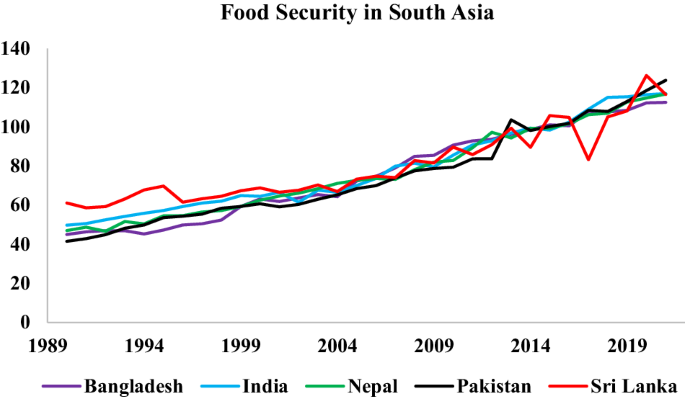
Empirical literature review
An empirical literature review entails a comprehensive and meticulous examination of previous scholarly research and investigations within a certain field of study, which is substantiated by empirical evidence. The objective of an empirical literature review is to provide a comprehensive overview of the existing knowledge and research within a certain academic domain, with the intention of identifying any existing gaps or discrepancies, and highlighting the strengths and weaknesses of previous studies. There are several studies that highlight the unfavorable consequences of climatic change on crop production, livestock, and fisheries. Food security is a universal human right that can be satisfied by preserving a sustainable food supply and health conditions (Pérez-Escamilla, 2017). Nearly 820 million people experience food shortages due to meteorological catastrophes in least-developed and developing countries (World Health Organization, 2018).
Climate change and food security
The issue of food security is closely linked to the phenomenon of climate change. The consequences of climate change include multiple issues such as an increase in the average global temperature, rising sea levels, the melting of glaciers, degradation of forests, salinization of soil, and loss of biodiversity (Nishimura, 2018). One of the primary sources of food comes from agriculture which is adversely affected by the weather and climatic risks, which adds to global deprivation and food insecurity (Connolly-Boutin and Smit, 2016). The climate risks are anticipated to push around 122 million individuals, specifically farmers, into severe poverty by 2030 (FAO, 2019). In developing countries, most of the economic and social risks are caused by floods, heavy storms, cyclones, and drought (Nhundu et al., 2021). The recent occurrence of floods in South Asia has resulted in the loss of crop production and livelihood as it has damaged the farmed valuable assets, and shortages of food have led to low food consumption. In developing states, rural areas are more prone to floods due to a lack of assets and adaptive approaches (Fahad and Jing, 2018). Moreover, climate variability has severe repercussions on regions that are heavily reliant on the agricultural sector causing ecological collapse, water scarcity, drought, and desertification (Adhikari et al., 2015; Muchuru and Nhamo, 2019) reducing the production of staple crops such as rice (Van Oort and Zwart, 2018), wheat, and maize (Murray-Tortarolo et al., 2018; Trnka et al., 2019). Furthermore, livestock products are an essential food supply due to their high energy and protein density as well as their additional nutritional value. Nevertheless, heat stress, drought, and unevenly distributed water availability severely affect the production of livestock. The increased temperature, in particular, hampers forage growth which is important for the growth of livestock (Rojas-Downing et al., 2017; Cheng et al., 2022). Rising heat stress causes respiration, pulse, and heart rate issues in livestock, as they are not able to disseminate heat to keep their body’s homoeothermic balance (Rashamol et al., 2018). Both flood and drought are dangerous to the well-being of animals causing death, morbidity, disease and parasite attack, and the outbreak of new infections (Nardone et al., 2010; Rojas-Downing et al., 2017). Additionally, heat stress negatively affects the immune function of livestock and makes them more exposed to diseases like mastitis which leads to a rise in the death rate (Dahl et al., 2020). Therefore, climate change reduces efficiency in milk production, feed intake, and reproduction and thus affects the immune system of livestock. Similarly, there are several studies that argue that changes in temperatures and high sea levels cause the extinction of fish species (Ding et al., 2017; Dey et al., 2016; Lauria et al., 2018; Moustache, 2017). Fish are more vulnerable to climate change because it affects hydrological dynamics and water quality (Ruaro et al., 2019; Barbarossa et al., 2021) and magnifies the negative impact on the freshwater ecosystem, as well as increasing the biodiversity crisis, which reduces the diversity of species and diets, which can lead to nutritional deficiencies and malnutrition (Reid et al., 2019).
Agricultural credit and food security
In developing countries, food insecurity drives millions into poverty, unemployment, and health issues. The effect of poverty and hunger can be minimized by focusing on agricultural reforms, including agricultural finance to mitigate financial constraints (Gowing and Palmer, 2008). Alongside such reforms, the adoption of contemporary technologies in agricultural operations is crucial for agricultural expansion and rural economic progress (Aryal et al., 2018). The key determinants of agricultural production include institutional, socio-economic, technological, and infrastructural factors; consequently, developing farms’ input, innovation through agricultural research, and improved infrastructure such as roads, irrigation areas, markets, storage facilities, and processing assist in increasing agricultural productivity and growth (Popkin, 2006; Brizmohun, 2019; Lokonon and Mbaye, 2018). It is mostly low-income individuals who are involved in the farming sector and so lack the finance to have increased inputs and embrace modern technologies to increase agricultural production (Malik and Nazli, 1999) while, access to credit can solve their financial concerns to some extent (Adams, Hunter, 2019). Unfortunately, farmers encounter a significant obstacle when seeking loans due to the insufficiency of collateral and the low-risk tolerance of lenders (Manoharan and Varkey, 2022). Therefore, it can be inferred that the presence of liquidity limitations has the potential to negatively impact agricultural output and food security, as shown by studies conducted by Asiedu et al. (2013) and Awotide et al. (2015). In addition, Karki et al. (2020) also found that lack of credit, technological backwardness, and climate change are the problems encountered by the small farmers in Nepal. The development of formal credit institutions and flexible loan terms for farmers will help them to endure the rising input costs and increase agricultural output (Rosemary, 2001). Furthermore, to mitigate the effect of climatic risk, agricultural credit schemes are required to invest in climate adaptive technologies (He et al., 2022). Agricultural loan programs and credit guarantees from formal institutions are essential in areas prone to high rainfall, floods, insect assaults, and other natural disasters, and timely credit availability boosts agricultural productivity. Using the Johansen cointegration approach, Chisasa and Makina (2015) demonstrated that credit availability benefits in raising agricultural output levels. Ogbuabor and Nwosu (2017) discovered, using time sequence data from Nigeria from 1981 to 2014, that providing loans at low interest rates had a significant and increasing influence on agricultural growth. Similarly, Narayanan (2016) discovered that when compared to agricultural GDP, the purchase of all inputs (tractor, fertilizers, pesticides, and other physical quantities) is more sensitive to agricultural credit. Similarly, Gasques et al. (2017) shown that rural financing had a progressive influence on the economic progress of Brazilian agriculture. Shuaibu and Nchake (2021), Osabohien et al. (2022), and Moahid et al. (2023) are among the other researchers that indicate the beneficial influence of loan availability on agricultural development.
Renewable energy and food security
Sustainable energy is essential to achieving food security in the long term. In order to support the world’s rapidly growing population, practices such as turning forests into cropland and using more pesticides and fertilizers have been adopted. All of these activities have increased agricultural emissions by more than 60% (Fróna et al., 2019). In addition, the agriculture sector relies heavily on intensive energy for agricultural operations to meet the anticipated food requirement (de Jonge, 2004) and this increases the prevalence of environmental issues. Many researchers are of the view that agricultural production and energy are interrelated because the increase in prices of oil, natural gas, and coal leads not only to increased input costs but also to increased food prices (Woods et al., 2010; Behera, Sahoo, 2022). On the other hand, to satisfy the anticipated food demand, the combustion of fossil fuel, biomass consumption, and deforestation cause environmental deterioration due to a loss of biodiversity and greenhouse gas (GHG) emissions (Pendrill et al., 2019), and also increase concerns about agricultural production (Rehman et al., 2020). Furthermore, agricultural machines and equipment are driven by fossil fuels (Chel and Kaushik, 2011). According to the FAO (2020), around 20% of global CO2 emissions can be attributed to agricultural production, specifically the combustion of fossil fuels that release gaseous pollutants into the environment (Kastner et al., 2012; Gorjian et al., 2021). Consequently, this contributes to environmental degradation and has adverse impacts on both the climate and public health (Gorjian et al., 2020; Kipkoech et al., 2022). Several studies have shown that GHG emissions from agricultural enterprises as well as the use of chemical fertilizers are threats to food security and sustainability (Olanipekun et al., 2019; Hafeez et al., 2020; Aitkazina et al., 2019), whereas renewable energy sources mitigate the emission of GHGs and air pollutants and combat global warming (Ben Jebli and Ben Youssef, 2017; Eyuboglu and Uzar, 2020). A sustainable environment contributes to sustainable agriculture by supplying fundamental resources such as rich soil, clean water, and a stable climate required for agriculture. This necessitates a shift from fossil fuel-based energy to renewable energy. Kinda (2021) found evidence for the constructive effect of renewable energy on food security. Bioenergy from crop residues, as the substitute for fossil fuel, can generate additional income for farmers, thereby enhancing their ability to ensure a sufficient supply of food (Asamoah, 2020). Similarly, Naseem, Guang Ji (2021) found that endorsing renewable energy and emission-free techniques in agriculture reduces the sector’s massive CO2 emissions. Consequently, food security can be enhanced by using renewable energy production as it leads to environmental sustainability (Vysochyna et al., 2020). By shifting agricultural operations to clean energy, we reduce the carbon footprint of food production, mitigating climate change’s adverse impacts on agriculture.
Methodologies
This study follows the framework developed by Thomson and Metz (1997) that serves as the foundation for the conceptual model for food security. According to this framework, the availability of food is essential to all models of food security. Due to the interdependence between food production and food availability and accessibility, it is evident that food production has a significant role in influencing food security. A decrease in food production may lead to a shortage of food, higher prices, and an increased susceptibility to food insecurity. Therefore, for empirical analysis, this study uses a food production index to gauge food security. The index of food production was also used by Zhu (2016) and Mahrous (2019) to measure food security. Based on the studies discussed in the preceding section, food security is a function of the following variables:
![]()
In addition, the population and inflation rate are taken as control variables. To empirically analyze the dynamic relationship between food security, climate change, agricultural credit, and renewable energy, we have used panel data. The following is a description of the econometric model used:
![]()
where FS indicates food security in time t across the country i. Climate is climate change, RE is renewable energy, AgriC is agricultural credit, Inf is inflation and Pop is the population, and \( u_{it} \) is the residual term. All variables are taken in log form.
Data source.We have selected the panel of South Asian countries that consists of Pakistan, Bangladesh, India, Sri Lanka, and Nepal between 1990 and 2021. For food security, the WDI’s data on the food production index is used. The data on renewable energy, which indicates the total consumption of renewable energy sources including wind, solar, hydropower, and biofuels, is gathered from the IEA. For climate change, we have taken the FAO’s data on temperature change as a proxy, and the data for agricultural credit have also been collected from the FAO. The data on the control variables, i.e., population and inflation, have been collected from the WDI database.
Empirical strategy.To examine the effect of climatic change, renewable energy, and agricultural credit, we have employed the dynamic common correlation effect (DCCE) estimation method developed by Chudik and Pesaran (2015). This method accounts for slope heterogeneity, cross-sectional dependence, and endogeneity issues and provides reliable estimates. In technical terms, DCCE estimates the weakly exogenous explanatory variables and tackles the cross-sectional dependency issue in the panel data. Irrespective of these features, DCCE performs well in the presence of structural breaks and unbalanced data as well as handling small sample size biases (Ditzen, 2018). The equation for this strategy, which calculates both the short and long-run consequences of the model, is shown below:
![]()
Table 1 Descriptive statistics.
| Variables | Obs | Mean | Std. Dev. | Min | Max | Skewness | Kurtosis |
|---|---|---|---|---|---|---|---|
| FS | 160 | 77.32846 | 21.87534 | 41.48 | 126.18 | 0.447 | 1.967 |
| Climate | 160 | 0.527563 | 0.422259 | -0.403 | 1.441 | -0.193 | 2.063 |
| RE | 160 | 57.84841 | 18.51619 | 21.24833 | 95.11971 | -0.144 | 1.976 |
| AgriC | 160 | 13657.83 | 36131.01 | 4.268098 | 172348.5 | 2.879 | 9.101 |
| Inf | 160 | 7.601505 | 3.760278 | 2.007174 | 22.5645 | 1.192 | 4.120 |
| Pop | 160 | 2.99e+08 | 4.36e+08 | 1.73e+07 | 1.39e+09 | 0.859 | 2.232 |
where i and t are the cross section and time while FSit is the dependent variable, and FSit − 1 is the lag of dependent variable. Zit represents explanatory variables. PT shows the lag of cross-sectional averages, while γzip and 6FSip are the unobserved common factors.
There is a growing association among macroeconomic indicators across countries as a result of globalization, economic integration, trade openness, shared borders, and spillover effects, etc., which makes it crucial to take into account the cross-sectional dependency in the panel dataset before estimating the main model, as this can prevent the estimates from being infective and inconsistent. In order to avoid such consequences, researchers use a cross-sectional dependence test for panel regression (Mensah et al., 2019; Baloch et al., 2019; Dong et al., 2019; Usman et al., 2022). Therefore, the Lagrange multiplier statistic found by Breusch and Pagan (1980) is used to perform CD tests in this investigation. Another rationale for specifically applying the LM test is that T is larger than N, and the equation is as follows:
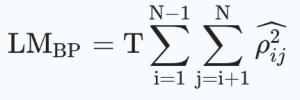
where N and T indicate panel data size and period, while pij is the correlation coefficient.
Next, we used Pesaran (2007) cross-sectionally augmented IPS (CIPS) and cross-sectional ADF (CADF) tests in order to verify the stationarity of our variables. Both of these tests provide dependable regression outcomes despite considering the confounding factor of CSD. The following is the mathematical expression for CADF:
![]()
Whereas CIPS is expressed as follows:

After a stationarity check, we used the Westerlund (2006) test to look into the long-run relationships between food security and the other explanatory variables of the selected countries. Using the bootstrap method, the Westerlund (2006) cointegration test yields accurate results in the presence of CD, heterogeneity, and small sample sizes. This test is the combination of two pooled and two grouped mean statistics:
![]()
In the above equation, d stands for deterministic component, and m and n are used for lags and lead, respectively. The test statistic of the Westerlund approach is as follows:
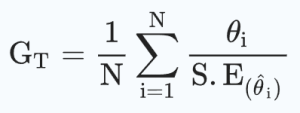
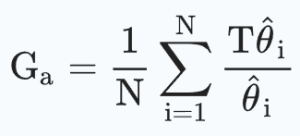
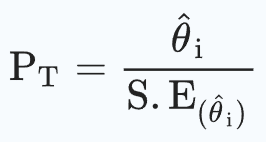

Results and discussion
Before embarking on an econometric approach, we conducted descriptive analysis to assess and comprehend the data structure. The descriptive statistical summary is shown in Table 1. The table shows the summary statistic of all the variables over the period 1990 to 2021. The mean value of food security is 77.32846, with minimum and maximum values of 41.48 and 126.18, respectively. The standard deviation of food security is 21.87534, which depicts data dispersed near the average value. Skewness is closer to zero, indicating a symmetric distribution while the value of kurtosis is 1.967, which shows leptokurtic distribution. The mean value of renewable energy is 57.84841 whereas the value of the standard deviation is 18.51619, which indicates that there is some deviation around the mean value. The minimum and maximum values are observed to be 21.24833 and 95.11971, respectively. The value of skewness and kurtosis shows that the data is approximately normally distributed. The mean value of the population is 2.99e+08. The value of the standard deviation is 4.36e+08 while the minimum and maximum values are 1.73e+07 and 1.39e+09, respectively, showing the least dispersion in the data. The value of skewness is considerably different from zero, indicating a skewed distribution. The mean rate of inflation is often seen to be 7.601505. The range of values is rather tight, with a standard deviation of 3.760278, indicating that most values are located around the mean, and the minimum and maximum are 2.007174 and 22.5645, respectively, indicating a modest amount of dispersion. A low skewness number indicates a symmetric distribution, whereas a high kurtosis value indicates a platykurtic one. The minimum and maximum values of climate change are −0.403 and 1.441, respectively, with a standard deviation of 0.422259 and an average of 0.527563. The skewness score indicates a leftward bias, whereas the kurtosis value is closer to 3 and is indicative of a rather normal distribution. Agricultural credit, in comparison, has a much larger standard deviation 36131.01 than the mean value of 13657.83. The lowest possible value is 4.268098, and the highest possible value is 172348.5. However, the value of skewness and kurtosis shows that the distribution is quite normal.
Table 2 Biased-adjusted LM-CD Test
| Test | Statistic | P value |
|---|---|---|
| LM | 16.44 | 0.0876* |
| LM adj | 3.10 | 0.0019*** |
| LM CD | 2.66 | 0.0076*** |
**, signifies the 1%, and 10% levels of significance.
Table 3 The outcome of the CADF and CIPS Unit Root Tests
| Variables | CADF Level | CADF 1st Difference | CIPS Level | CIPS 1st Difference |
|---|---|---|---|---|
| FS | -2.213 (0.151) | -4.699 (0.000)*** | -3.155 (0.000)*** | -5.974 (0.000)*** |
| Climate | -1.063 (0.192) | -5.446 (0.000)*** | -2.114 (0.082)* | -5.190 (0.000)*** |
| RE | -1.069 (0.955) | -3.139 (0.001)*** | -1.417 (0.358) | -5.224 (0.000)*** |
| AgriC | -1.521 (0.731) | -3.225 (0.000)*** | -1.556 (0.457) | -4.723 (0.000)*** |
| Inf | -1.777 (0.503) | -3.832 (0.000)*** | -1.773 (0.345) | -4.221 (0.000)*** |
| Pop | -1.258 (0.301) | -2.382 (0.076)* | -1.358 (0.242) | -2.516 (0.381) |
**, signifies the 1% and 10% levels of significance.
Table 4 Outcomes of the Pedroni-Cointegration Test
| Statistic | t value | Prob. Value |
|---|---|---|
| Modified PP | -0.847 | 0.127 |
| PP | -5.014 | 0.000*** |
| ADF | -5.138 | 0.000*** |
*** signifies the 1% levels of significance.
Table 5 Outcome of the Westerlund ECM cointegration test
| Statistic | Value | Z-stat | Prob. |
|---|---|---|---|
| Gt | -3.096 | -1.972 | 0.024** |
| Ga | -8.313 | 0.993 | 0.840 |
| Pt | -3.230 | -1.237 | 0.091* |
| Pa | -9.534 | -0.422 | 0.336 |
*, signifies the 5% and 10% levels of significance.
Table 6 Results of the dynamic common correlated effect approach
Short-run estimates
| Variables | Coefficient | Z-stat | P value |
|---|---|---|---|
| Climate | -0.043 | -2.38 | 0.018** |
| RE | 0.366 | 1.70 | 0.089* |
| AgriC | 0.563 | 1.58 | 0.092* |
| Inf | -0.087 | -1.86 | 0.062* |
| Pop | 1.46 | 0.83 | 0.405 |
Long-run estimates
| Variables | Coefficient | Z-stat | P value |
|---|---|---|---|
| Climate | -0.165 | -1.71 | 0.081* |
| RE | 0.574 | 1.53 | 0.130 |
| AgriC | 0.215 | 2.09 | 0.036** |
| Inf | -0.148 | -2.11 | 0.021** |
| Pop | -1.538 | -1.89 | 0.063* |
Other estimates
| Statistic | Value |
|---|---|
| CD-Stat | 2.538 (0.029)*** |
| R-sq | 0.48 |
| F-stat | 2.872 (0.063)*** |
| R-sq mg | 0.97 |
**, signifies the 1%, and 10% levels of significance.
inconsistent regression results. In this investigation, the use of biased adjusted LM-CD tests was necessitated due to the discrepancy between the number of cross-sections and the period. The results of the LM-CD analysis are shown in Table 2. As the p-values are less than 0.05, we reject the null hypothesis of cross-sectional independence and instead draw the conclusion that there is a cross-sectional interdependence.
Since the CD-test implies that the cross-sections are connected, the CIPS and CADF tests by Pesaran (2007) are used to evaluate variable stationarity. CIPS and CADF tests regulate the dependence between panels in a cross-sectional pattern. The CIPS and CADF outcomes are shown in Table 3.
Based on the findings of the CADF analysis, it is seen that the CIPS test reveals a stable level for food security and climate change variables, while the other variables exhibit stationarity at first differences. Notably, all variables demonstrate time-invariance in their first differences. Hence, it is essential to investigate the potential linkage between the variables of the model in a state of long-term equilibrium.
In Table 4, the results of the cointegration test by Pedroni (1999) are shown. According to the Pedroni residual-based test of cointegration, the factors are linked over the long term. According to Westerlund and Edgerton (2008), the majority of cointegration tests in use cannot handle structural discontinuities in long data. Moreover, the first-generation tests also include the assumption that there is no dependency among cross-sections; however, as a result of globalization cross-sectional dependence is now the norm rather than the exception in today’s society. Early studies largely overlooked these concerns, but Westerlund (2006) improved the cointegration tests by addressing them. Additionally, serial correlation, heteroskedasticity, cross-sectional dependence, and structural breakdowns are all handled by the approach suggested by Westerlund and Edgerton (2008) which yields efficient outcomes even in small samples. As a result, it was used to probe for a potential indeterminate relationship between the variables. Results from the Westerlund cointegration test are shown in Table 5. Based on these data, we reject the null hypothesis and conclude that cointegration occurs at the 5% level of significance; the group statistic is significant, while at the 10% level of significance, the panel statistic is significant.
The DCCE technique introduced by Chudik and Pesaran (2015) is used to estimate short- and long-term parameters while taking cross-sectional dependence into consideration. Table 6 displays the final output of the DCCE model. A one percentage point increase in renewable energy consumption increases food security by around 0.37 percentage points in the short-run, therefore this is a positive and statistically significant coefficient. The use of renewable energy not only addresses many concerns associated with fossil fuels but also enhances food security. The use of renewable energy sources serves as a protective measure for farmers, as it mitigates the negative impacts on the environment and reduces dependence on imported fuels. The use of renewable energy in the agricultural sector has the potential to provide many benefits, including reduced energy expenses, increased profitability, and a significant enhancement in food security (Premalatha et al., 2011). This finding is further corroborated by Chel and Kaushik (2011), who argue that the concept of sustainable agriculture for economic sustainability, which entails minimizing the utilization of limited natural resources and mitigating adverse environmental impacts while enhancing agricultural productivity and yield, aligns with the goal of increasing the proportion of renewable energy employed in agricultural operations. But renewable energy has a negligible effect on food security in the long term. Due to their heavy reliance on agricultural and vast forest resources, many of the developing countries have biomass supplies as one of the major sources of energy but biomass can never completely meet the world’s energy needs without destroying the forest ecosystems; therefore it meets the demand for renewable energy sources in the short term only (Nonhebel, 2005), while for a long-term and sustainable solution, developing countries need to invest in the PV system to meet energy needs in the agriculture system. In a nutshell, in the short term, renewable energy can help to preserve ecosystems and improve the quality of soil and water, which indirectly benefits agriculture. On the other hand, over the long run, population expansion and rising energy demands eventually outweigh these advantages and its impact on agricultural production becomes negligible. Moreover, because energy transition doesn’t directly address fundamental problems like land usage, agricultural methods, and distribution systems that are essential for long-term food security, its long-term advantages are constrained.
According to the results given in Table 6, as a consequence of the worsening climatic conditions, global food supplies are coming under growing strain, and this has been proven to have an adverse effect on food security both in the short- and long-run. One percent change in climate reduces food security by 0.043 percent in the short run and 0.165 percent in the long run. The reason for the adverse effect of climate change on food security is that farmers find it more difficult to plan and control production as a result of changing planting seasons and weather patterns. As a result, the future capability of the farming sector and the food supply is gravely threatened by the harsh climate. Attempts to combat climate change by reducing GHG emissions throughout the economy may, however, have a detrimental impact on food security owing to indirect impacts on the price and availability of essential agricultural commodities. This finding is consistent with the findings of Nelson et al. (2014) and Hasegawa et al. (2018), who predict that by 2050 significant agricultural yields will be reduced by 17% due to predicted climate change, while market prices will increase by 20% and related consumption will decrease by 3% as a result of adaptations in production across regions. Climate change has a negative impact on food security because it reduces the intensity and length of suitable heat and water conditions for agricultural operations (Lobell et al., 2015; Schauburger et al., 2017; Aryal et al., 2020).
The coefficients shown in Table 6 indicate that the beneficial influence of credit availability on food security is greater in the long-run compared to the short-run. Additionally, the coefficient for agricultural credit is significant and positive in both time periods. The reason for the positive coefficient value lies in the fact that access to credit for agriculture-related activities helps cultivators to invest in ways of enhancing farm productivity which eventually affects their earnings and thus their living standards. In the short-run, easy access to credit makes it easier for farmers to invest in fertilizers, pesticides, and quality seeds which affect the production of the agricultural sector. The improved access to loans for agricultural activities thus results in an increase in farm productivity, leading to more production and increased food security. The positive effect of credit access on food security is due to the reason that long-term availability of agricultural credit aids farmers in making investments in cutting-edge, money-saving machinery and methods, as well as in diversifying their output. Thus, access to agricultural credit, by helping farmers shield themselves from risks and uncertainties, increases the production of the agricultural sector and thereby reduces food insecurity. These conclusions are in harmony with the research of Abdallah (2016), Bidisha et al. (2017), Iftikhar and Mahmood (2017), and Asghar and Salman (2018), who are of the view that the availability of credit brings technical efficiency and improves agricultural production.
A one percent increase in population is shown to reduce food security by 1.538 percent; but this effect is not seen in the short term. The force driving consumption is population growth which raises the number of mouths that need to be fed. The growing population is the cause of the increasing demand for resources that are both diminishing and scarce, for example, land and water. The current model of an expanding population relying on limited resources is unsustainable, which highlights how crucial it is to work toward “resource efficiency” (Mc Carthy et al., 2018). Our result is consistent with the theory of Malthus (1986), who claimed that population growth would eventually reduce the world’s capacity to feed itself because populations grow at a rate that outpaces the development of land that is suitable for growing crops. However, critics argue that Malthus underestimated humans’ capacity to innovate and adapt to resource constraints, and that he neglected the prospect of improving agricultural systems to address population growth concerns. The enduring impact of population on food security aligns with the findings of Schmitz et al. (2015), Smith and Archer (2020), and Molotoks et al. (2021), who posit that the expansion of the global population raises the probability that conventional food sources will prove insufficient to sustain future generations over an extended period of time.
It is observed that one percent increase in inflation affects food security adversely by 0.087 percent in the short-run and reduces food security by 0.148 percent in the long-run. Although inflation has a short-term negative impact on food security, its long-term impact is far more significant. If all other conditions remain constant, higher commodity prices will raise demand globally for agricultural inputs such as fertilizers, seeds, farm equipment, etc., pushing up input prices (Van Zyl, 1986). Furthermore, inflation raises the cost of all imported inputs and machinery, wages, and transportation costs which leads to a high cost of production and lower agricultural production, and high food prices. This result accords with the findings of Durevall et al. (2013) and Shei and Thompson (2019). It also affects the consumption of food by affecting the purchasing power of consumers. Thus, by affecting the demand and provision of food, inflation has a detrimental effect on food security.
Concluding remarks
The impact of agricultural credit, climate change, and renewable energy on South Asia’s food security is assessed in this study. Based on our findings, we can say that climate change has a long-term and short-term negative effect on food availability and increases the incidence of food insecurity in South Asia. The adoption of renewable energy sources, on the other hand, has a beneficial impact on food security in the short term but a negligible impact in the long term. In the short-run, the use of renewable energy can help to preserve ecosystems and improve the quality of soil and water, which affects the agriculture production. On the other hand, over the long-run, population expansion and rising energy demands eventually outweigh these advantages and its impact on agricultural production becomes negligible. Moreover, findings show that farmers are able to raise their yields when they have access to credit, which allows them to spend less time worrying about money. Thus, the supply of agricultural credit has the potential to improve both long- and short-term food security. The control variables, inflation and population, affects food security adversely in the long-run whereas in the short-run the influence of population on food security is insignificant while inflation increases food insecurity in the short-run as well. Thus, this study concluded, based on the data presented, that the countries in the South Asian region need to make investments in infrastructure that are climate-resilient, cultivate drought-resistant crops, implement supplementary reinforced agricultural practices, and improve weather forecasting capabilities in order to alleviate the unfavorable effect of changing climate on food security.
Practical implications
In light of challenges brought on by climate change, South Asian governments should place a high priority on both food and energy security. The implementation of climate services, such as specialized weather forecasts and alerts, can enable farmers to make knowledgeable decisions, optimize resource use, and reduce weather-related losses, ultimately encouraging resilient agricultural practices and enhancing overall regional stability.
In addition, to enhance food security and combat climate change, it’s crucial to shift away from fossil fuels and boost renewable energy integration in agriculture. Specifically, promoting small-scale solar panels within the sector can increase agricultural output and reduce greenhouse gas emissions, benefiting both productivity and the environment in South Asia.
On the other hand, since the availability of credit improves food security, the government should help the financial sector in enhancing its capacity to provide farmers with loans on easy terms and conditions. Access to credit is critical for small-scale farmers in South Asia, who often lack the resources to invest in inputs such as seeds, fertilizers, and machinery. Agricultural credit can help farmers improve productivity, diversify crops, and adapt to changing climate conditions. However, high interest rates and limited access to credit can make it difficult for small-scale farmers to access the funds they need; therefore commercial banks should provide loans to serious farmers at a low-interest rate to achieve sustainable food production.
Author
-
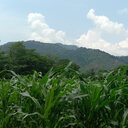
Dr. Abdul Rehman can be contacted via researchgate for collaboration in the emerging field of economics including; Energy Economics, Environmental Economics, Agricultural Economics, Climate Economics, Health Economics, Energy Finance, Regional Rural Development, Regional Agricultural Development, Food Economics, Economics and Pollution, and Climate Change.

